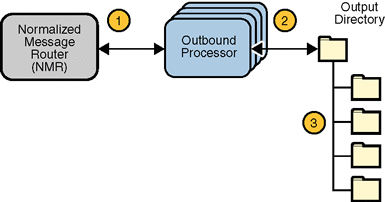Outbound Message Processing
Outbound message processing always utilizes File Name Patterns to ensure that messages are processed once only and are not overwritten.
The life cycle of an outbound message can be explained using the following illustration.

The process flow can be described by the following steps:
-
Outbound processors wait on the Normalized Message Router for outbound messages. The number of available outbound processors is configured by the runtime parameter Outbound Threads().
-
When an outbound message is available, an outbound processor takes the message, denormalizes the message, and writes the message payload to the specified file destination.
-
A file name pattern is used to generate the unique message name. The file name pattern is specified by the WSDL File message element attribute fileNameIsPattern().
For example, a UUID can be added to the file name using the following value: output._%u.dat(). When persisted sequence numbering is used to provide a file name pattern, the outbound processor reads the sequence number from the my_sequence directory and adds this number to the file name. It then increments the number by one and writes the new number back to the my_sequence directory. This process is synchronized so that only one outbound process can access the my_sequence directory at any time, ensuring that the persisted sequence number retains its integrity.
- © 2010, Oracle Corporation and/or its affiliates
